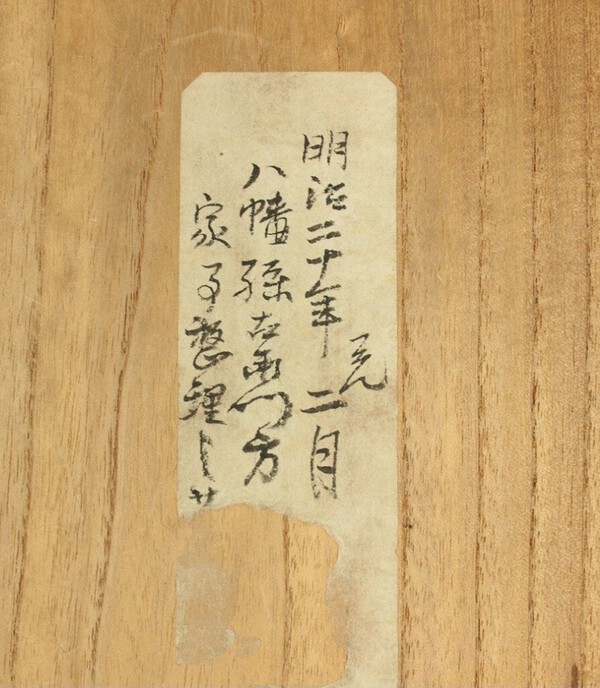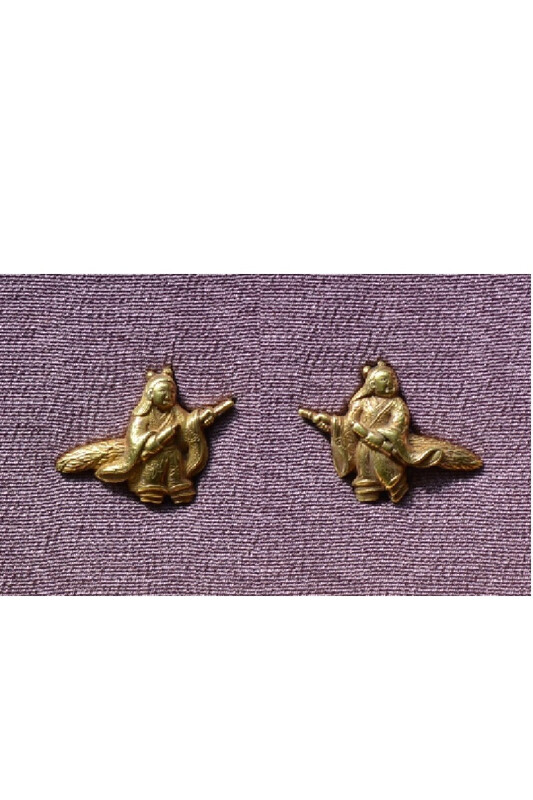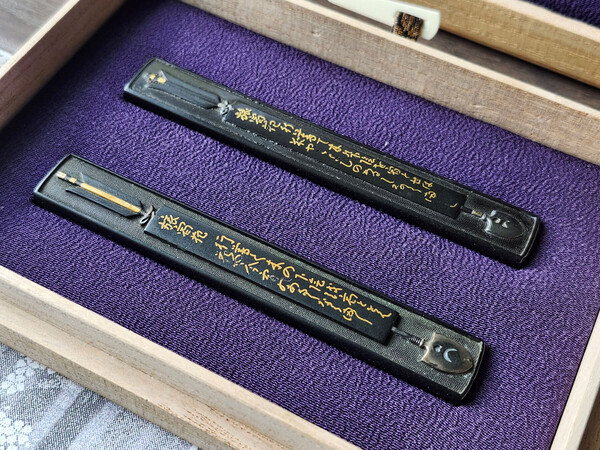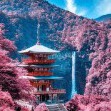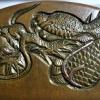All Activity
- Past hour
-
I didn't expect it to be original so I didn't payed a fortune for it too. Here you go siganture, also box have some writings on it
-
Yasukuni jinja has massive naginata that I believe is signed 九州筑前住人源信国平四郎. Unfortunately I don't have this in any references just have seen it 3 times at the museum. They have Muromachi dating for this massive naginata in koshirae (and given the size I could easily believe their description). So this one would seem to possibly predate the Yoshimasa smiths. However it could be possible that Yasukuni jinja description is bit too early and the blade would be a massive early Edo period naginata.
-
I suspect this tsuba is higo and dates to the late edo period. It's the typical 3 pine design with very nice deep black iron. It's big thick solid tsuba and looks good mounted. 79 x 77 x 6mm Comes with the tsuba box pictured. Price $300 including shipping worldwide and paypal fee.
-
I'm sorry to give you such bad news after you already bought it but this is a reproduction, probably early/mid Showa or Taisho. Originals Kanō Tan'yū 狩野 探幽 kakejiku scrolls are selling for thousands of euro in reputable auction houses (Catawiki is a scam) and if I'm not mistaken are prohibited to be exported from Japan Also the photos are not available at CW site, only 5 thumbnail shots so I can't see the signature/seals
-
And some other Kaga works. f/k are Kaga Kinko. Lots of inlay work, and high polish almost as if it were finished with a painter's coat of gloss. The gold menuki are mine. I like the myth behind these two well known characters. The tsuba is not mine. I've sold all my Kaga tsuba, kinda waiting for a really incredible one to come along. I would love one of the multi-butterfly examples. Common to almost all of the Kaga Goto and Kaga Kinko works is a mix of gold, good to great shakudo, and silver. Every one of these pieces has a fair bit of silver either obvious or not so obvious. Some of it is heavily oxidized, and I wouldn't dare to clean it.
-
Tyler sword started following Honami Family/Kinzogan Mei
-
Honami Family/Kinzogan Mei
Tyler sword replied to William Jennings's topic in General Nihonto Related Discussion
-
New Member Introductions
Bloodaxe924 replied to Dusty62's topic in General Nihonto Related Discussion
As much as I enjoy Asian art of all mediums, I am much more of an amateur genealogist than a collector. My passion is in finding where my ancestors came from and their stories along the way. This sword and silk painting are just a small blip on the map of my family’s story and in my opinion never truly belonged to them other than the fact that my uncle was on midway island. No disrespect for military collectors, it’s just not sentimental to me in a way that some things are that directly tell a part of my family’s history. I have a deep respect for Japanese culture and art and find it very interesting, but I am not financially stable enough to collect any of it. Especially recently as I have been on disability due to medical issues. I was asking because I was curious about not only the value, but the history behind the sword. I’m not sure if I want to sell it currently, but I would love for it to go to someone like the kind folks I’ve conversed with on this forum. I know anyone on here would care for it and respect it and appreciate as much as I have and even more. Thank you for the information you’ve shared. I was really stumped about the black saya. Sounds like a lot of folks are as well 😂 -
As Ken said, the Kaga Kinko Taikan is one of the best [Tosogu Porn] books. I have to say I paid a lot more for mine than the one Grey Doffin has on his website. The book is good enough that I thought of buying a second copy. @Charlie C You are correct. Top one is Goto Kenjo and bottom one is Goto Tokujo. Though of the same design, when you get to study them closely (at different angles), you begin to sense patterns in terms of how they 'framed' the design and executed it. One thing that I will share about Goto Kenjo is that he liked to recess his works more. If you study these two kozuka at an angle, you will find the walls of the frame of the kozuka higher and the design set a fraction deeper. I am not sure if I have a picture of this, but will post the best one I can find. It should be attached to this reply.
-
I had a long discussion with him about a Kanabo katana. In the end, I passed on it; the blade was too damaged, and I preferred to buy a nihonto on the forum. Thanks to some forum members for making me aware of my future mistake. In quotes, more security on the listing, there's transparency with the seller, and you pay for a better blade at the same price.
-
Tyler sword joined the community
- Today
-
@Mantis dude Thanks for your insights Ken! I do agree that using hira zougan is a major hallmark of the general Kaga school, but it doesn't seem to differentiate the Kaga Kinko and the Kaga Goto. For example, the Mizuno family in the Kaga Kinko school produced many pieces without using hira zougan (see this https://www.kanazawa-bidai.ac.jp/institute/miz/miz-edo/sum-mizuno01.htm), and Kuwabara commented that the Kuwamura family in the Kaga Kinko school produced better nanako-ji than some later Goto main strain masters (though I was not able to find any pics online). The Kaga Goto school also seem to employ hira zougan as frequently as other Kaga people. And you are right, the NBTHK often just (lazily) say Kaga Zougan instead of specifying Goto or not when hira zougan is massively used in a fitting. Unfortunately I do not have the Taiken book - am trying to find one not so expensive ... @Curran Amazing collection! So the pic above is 顕乗 and below is 徳乗? This is one of the reasons why I say the Kaga Goto thing is a mess: 顕乗、程乗、覚乗 and others each bring something of their own into this melting pot and blend with local tradition, making the descendants undistinguishable. The metal purity seems to be a promising criterion, if the Gotos are believed to have better shakudo then the Kaga Goto may also have better ones than their local pupils. However, considering that the 理兵衛 and 勘兵衛 masters only stay for no more than 6 months in Kanazawa each year, it would make an amusing scene if they always travel with some huge chunk of secretly made high-quality shakudo. Please post some more pics so we can see the comparison!!
-
Just an FYI, I was curious about what papers are saying in reference to Kaga kinko, kaga goto and I think I have seen instances of Kaga zogan label also being used (i didn't do a good job of actually confirming that was written). I did find some descriptions of Kaga goto school employing nanako, deep carvings & varying inlay techniques (in essence goto type work). However, I'm not so sure that papers are actually reflecting all of this. in other words, I'm finding attributions that are being applied without any clear explanation. something I would label kaga goto has kaga kinko papers. This might be one of the instances where different evaluating groups papered using the terms interchangeably. This wasn't a deep dive study just a quick look at pieces with papers. Although, many do follow that pattern, several have not. So I'm just going to focus on the beauty and skill of all kaga types and leave the papering orgs study to others who are more knowledgeable/active in the paper process. A side note; anyone that hasn't seen the Kaga Kinko Taikan book is definitely missing out on a book of "sword porn". Some great pieces in that book and worthy of owning it, if you find one. Look forward to seeing more pieces.
-
If I get the opportunity, I’ll try to pick his brain about the topic at the upcoming show. I’ll make a note of it, because now I’m curious too
-
Its just that they have it hands with all their references next to them and still were undecided. Guys here from images with the emphasis on the mei. Who knows though, a fresh shinsa may come to an agreeable opinion.
-
That is exceptional work, very clean and precise. I would love to pick your brain in the future if I ever attempt this.
-
Hey Sam, one more quick thought if you ever have the chance to ask Brian in the future. Your original question to him regarded bohi, but what about blades with sohi? I’m curious if both grooves are cut, is that actually for utility or more to demonstrate the skill of the artist. Presumably fitting the seppa to one groove would be more than adequate to service its purpose, but that very much is a presumption on my part.
-
It depends. It can be a hold out "crazy uncle" judge (a bad session or such). @Lewis B you can have all my 7 or 8 Horyu result tags. So far, all have papered the next shinsa where I sent them in [usually the following year]. Many were Middle Weight to Light-Heavyweights. One Horyu is in shinsa_2.0 now and is a heavyweight. When a heavyweight, odds are probably more against a pass. So let us both see. My Horyu were all for fittings.
-
That would be fantastic is you find one. I would be very interested to see the depth of the seppa into the hi. Presumable it would not need to bottom out in order to serve its purpose.
-
I've never seen a gunto with a leather covered saya with fittings: https://www.jauce.com/auction/e1192352718?allow=1 It seems like the leather shrank over the year, and split from the kojiri at the tip.
-
I searched around and could not find an image example to share of a seppa with profile for a bohi. So it must not be super common. I already pester Brian enough and he's super busy, otherwise I'd ask him I think most seppa that I've encountered "in the wild" are generic ones too; but as @Stephen points out, a properly fitted seppa should be snug, therefore one should fit slightly higher then the other. Some more speculation: During WW2, we know that seppa were sometimes numbered on outfitted swords - presumably to keep the individual fitted parts together and not to mix them up during production and outfitting. BUT, WW2 also brought a lot of mass production and standardization; It would not surprise me if they pumped out seppa blanks to then be machined for individual swords. Furthermore, it would not surprise me if many of those seppa blanks worked "good enough" as is, especially later in the war or for civilian gunto. Sorry for all the speculation, but hey, seppa info is hard to find . If I get the opportunity, and if I remember, I’ll ask and maybe get a photo of a “bohi seppa” at the SF show in a couple weeks. -Sam
-

New Member Introductions
Bruce Pennington replied to Dusty62's topic in General Nihonto Related Discussion
Welcome, Shaun! Now that you've dipped your toe in the Japanese sword world, do you plan to start collecting? -
I have a wakizashi with a mei reading simply “Nobukuni Heishiro”. After research, this mei is associated with Chikuzen Yoshimasa (one of 3 generations), but usually “Nobukuni Heishiro” is a part of a much longer mei and usually reads: “Minamoto Nobukuni Heishiro Yoshimasa”. I am wondering if anyone has any thoughts about which generation might have signed this way? Or speculation for the shortened mei? My only thought is possibly this is an early blade of the second or third generation and the blade was made/signed while still working under the earlier generation and before assuming the role as head of the family name? Other thoughts?
-
What I always appreciated in finding in the sword the sepa size to fit the front and the back of the tsuba. That is to say both would on the tsuba next to saya But one would not slide all the way up the nakago to tsuba. Usually a sign that they were made for the sword and tsuba





